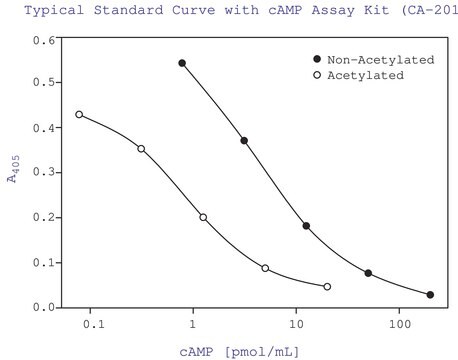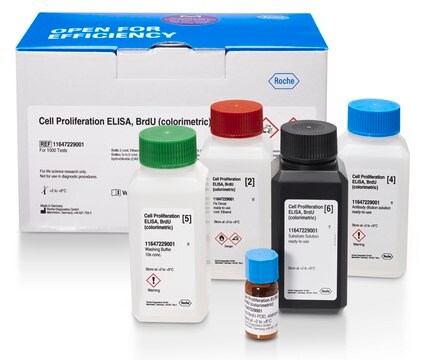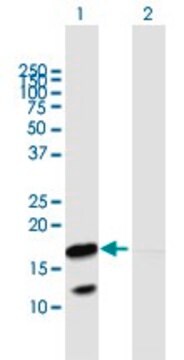2210-M
Cell Proliferation Assay Kit, WST dye; ELISA based
Faça loginpara ver os preços organizacionais e de contrato
About This Item
Código UNSPSC:
12161503
eCl@ss:
32161000
Produtos recomendados
reatividade de espécies
mouse, rat, human
técnica(s)
ELISA: suitable
Descrição geral
The Cell Proliferation Assay kit is used for fast and sensitive quantification of cell proliferation and viability. The assay is based on the cleavage of the tetrazolium salt WST-1 to formazan by cellular mitochondrial dehydrogenases. Expansion in the number of viable cells results in an increase in the overall activity of the mitochondrial dehydrogenases in the sample. The augmentation in enzyme activity leads to the increase in the amount of formazan dye formed. The formazan dye produced by viable cells can be quantified by a multiwell spectrophotometer (microplate reader) by measuring the absorbance of the dye solution at 440 nm. The assay can be used for the measurement of cell proliferation in response to growth factors, cytokines, mitogens and nutrients. It can also be used for the analysis of cytotoxic compounds like anticancer drugs and many other toxic agents and pharmaceutical compounds. This method is simple, requiring no washing, no harvesting and no solubilization steps, and it is faster and more sensitive than the MTT-based assay. The entire assay can be performed in one microplate.
Aplicação
PROTOCOL:
1. Culture cells (0.1-5x104/well in a 96-well microplate in a final volume of 100 μL/well culture medium in the absence or presence of various amounts of factors tested.Note: For toxicity assays, use more cells to start with (e.g. 5x104 - 5x105 cells/well).
2. Incubate cells for 24-96 hours.
3. Add 10 μL/well WST-1/ECS solution to each well.Note: If the cells are cultured in a different volume of culture medium, increase or decrease the amount of WST-1/ECS solution accordingly.
4. Incubate the cells for 0.5 to 4 hours in standard culture conditions.Note: The appropriate incubation time depends on the individual cell type and cell concentration used. Therefore it is recommended that you determine the optimal incubation time for each experimental setup used.
5. Shake thoroughly for one minute on a shaker.
6. Measure the absorbance of the treated and untreated samples using a microplate reader at 420-480 nm depending on the filters available. The reference wavelength should be more than 600 nm. Note: Using the same amount of culture medium and WST-1/ECS solution in an empty well as a blank position for the microplate reader.
1. Culture cells (0.1-5x104/well in a 96-well microplate in a final volume of 100 μL/well culture medium in the absence or presence of various amounts of factors tested.Note: For toxicity assays, use more cells to start with (e.g. 5x104 - 5x105 cells/well).
2. Incubate cells for 24-96 hours.
3. Add 10 μL/well WST-1/ECS solution to each well.Note: If the cells are cultured in a different volume of culture medium, increase or decrease the amount of WST-1/ECS solution accordingly.
4. Incubate the cells for 0.5 to 4 hours in standard culture conditions.Note: The appropriate incubation time depends on the individual cell type and cell concentration used. Therefore it is recommended that you determine the optimal incubation time for each experimental setup used.
5. Shake thoroughly for one minute on a shaker.
6. Measure the absorbance of the treated and untreated samples using a microplate reader at 420-480 nm depending on the filters available. The reference wavelength should be more than 600 nm. Note: Using the same amount of culture medium and WST-1/ECS solution in an empty well as a blank position for the microplate reader.
Componentes
WST-1 Reagent (lyophilized 1 vial Electro Coupling Solution (ECS) 5 mL
Armazenamento e estabilidade
Store kit components at -20°C for up to 1 year from date of purchase. Protect from light. After reconstituting the WST-1 reagent aliquot (1 mL is sufficient for assay with one 96-well microplate) and maintain at -20°C for up to 3 months. REAGENT PREPARATION: Dissolve the lyophilized WST-1 reagent with 5 mL of the Electro Coupling Solution (ECS). It should be purple-red in color. If the solution is yellow in color the aliquot should be discarded.
Exoneração de responsabilidade
Unless otherwise stated in our catalog or other company documentation accompanying the product(s), our products are intended for research use only and are not to be used for any other purpose, which includes but is not limited to, unauthorized commercial uses, in vitro diagnostic uses, ex vivo or in vivo therapeutic uses or any type of consumption or application to humans or animals.
Código de classe de armazenamento
10 - Combustible liquids
Classe de risco de água (WGK)
WGK 3
Certificados de análise (COA)
Busque Certificados de análise (COA) digitando o Número do Lote do produto. Os números de lote e remessa podem ser encontrados no rótulo de um produto após a palavra “Lot” ou “Batch”.
Já possui este produto?
Encontre a documentação dos produtos que você adquiriu recentemente na biblioteca de documentos.
Nossa equipe de cientistas tem experiência em todas as áreas de pesquisa, incluindo Life Sciences, ciência de materiais, síntese química, cromatografia, química analítica e muitas outras.
Entre em contato com a assistência técnica





